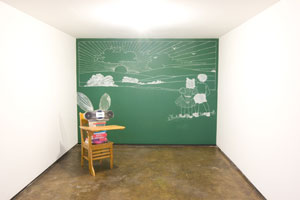The following is the text of Anjali Gupta‘s remarks from the College Art Association panel discussion, Can Anyone Be a Critic? The Collision
between Traditional Criticism and Blogging.
Rubén Méndez & Gregorio Samsa...first years at school and his nightmare...2007, Installation view, TPS San Antonio...Image courtesy the artists...Photo by Justin Parr
Is blogging criticism? To me, this is a qualitative question, and the most honest answer I can give you is, maybe. I think valid criticism depends on the writer, not necessarily the venue. Nor do I think being able to write good criticism is contingent upon academic prerequisites — a formal education and the speculative authority that implies. While it is true that some writers, regardless of education, experience, or format do not require the mediating hand of an editor to structure an argument, I can tell you that such individuals are a rarity. So without the reflection the editorial process enables, is blogging criticism? Sometimes. The biggest downside of the art blog is its ubiquity. Most just add to the obscenely large and sloppy heap of writing we already swallow as criticism, because even in the print arena, a critical tone and confrontational stance are all too often confused with criticism. But this cannot, in good faith, be blamed on the blog.
When I first started working as an editor, I was writing for both print and online publications including Glasstire, represented on this panel by founder and Executive Director Rainey Knudson. Personally, I never treated writing for a digital publication any differently than I did writing for print. In fact, Art Lies and Glasstire still share more than a few contributors who write features and reviews for Art Lies AND blog for Glasstire, which does suggest that these are not mutually exclusive activities.
While I didn’t find the transition from being a critic to critiquing the writing of others jarring, I did find it revelatory. I quickly realized that my predecessors had long been literally re-writing the bulk of journal. I have phased out this practice. This is not to say that I am opposed to working with inexperienced or even first time writers. Nor am not opposed to variance in tone or unorthodox style, as long as arguments are well supported. I am willing to go the extra mile for anyone willing to address and engage in the editorial process, however brutal it may sometimes be. I think the lack of an editorial filter is a major problem in blogging in general, especially blogs that self-categorize as “art criticism.” This manifests in a few key strategic and structural problems I also come across in “dead tree” publications, but they do seem more prevalent in the blogging arena.
- I’ve had it with the experiential approach to criticism. I really don’t need to know who you had dinner with last night. I could give a crap if it was a “clear and blustery day” when you visited such-and-such exhibition or what Paris smells like in the springtime. Nor do I care for exhaustive descriptions of how many paces, heel to toe, it took you to walk from one end of a gallery to the other, or what this personal journey meant to you.
- Snarky, unsupported quips have nothing to do with critical writing or thinking.
- Communicate — don’t alliterate. Relegate cutesy literary devices to the realm in which they belong — the weekly.
- A critic should not have to resort to interviewing artists to jump-start their thought process or spend half their word count quoting curatorial statements.
All of this builds up to what I think is the subtext of the question, is blogging criticism? While it invokes the revolving door discussion of the state of art criticism, what we need to be asking ourselves is what constitutes good criticism, which is arguably inseparable from the question, what is good writing? Any writer, in any field, regardless of background or education, has to earn their chops. This involves a process of specialization — a process that takes time and, for most, requires some guidance. For the budding critic, this might include the well-intentioned advice of graduate advisors, but in the post-graduate world —and for those of us without a formal education in the arts (myself included),it should also include a competent editor, especially in the beginning of one’s career. Blame it on the blog or the industry of the MFA and all that system implies, but “art critic” seems to be increasingly an entry-level position. In this light, perhaps another subtext to the question posed to this panel might be, to quote the president, “Is our children learning?”
Anjali Gupta is a freelance critic, editor and video producer based in San Antonio. She is Editor-in-Chief of Art Lies and her writing has appeared in periodicals such as tema celeste, Art Papers, Art Asia Pacific, artUS and Public Art Review, and catalogues including the Blanton Museum of Art: American Art Since 1900. She recently served as a Lecturer in the graduate studio art department at the University of Texas at Austin.






4 comments
Ms. Gupta says, “I think valid criticism depends on the writer, not necessarily the venue.†A couple of graphs later, however, she implies that no worthwhile criticism can be found in “the weekly,†a very specific type of venue and one that counts among its ranks award-winning publications such as the Dallas Observer, Houston Press, and, my employer, the Fort Worth Weekly (and also The Village Voice, in whose pages for years regularly appeared art criticism by Pulitzer-Prize nominee Jerry Saltz, and, if we’re going to get technical, The New Yorker also is a weekly).
Talk about painting with a broad brush — even if Ms. Gupta had spent the past couple of years studying the writing of every weekly art critic in the country, her opinion would still be nothing but a purely subjective manifestation of her classroom or studio experiences. The only material arbiter of good writing is the intelligent reader. Not Ms. Gupta. Not her professor friends. Not her students. Simply the intelligent reader, who doesn’t have to clog up the blogosphere (i.e., Glasstire), the lecture hall, or even the neighborhood bar with his or her criticisms of art criticism — he or she can simply turn the page.
BTW, I also love the irony in Ms. Gupta’s otherwise reasonable advice to young writers: “Communicate — don’t alliterate.â€
Translation: “Alliteration is gauche. But rhyme is cool, fool!â€
very well said.
need freelance writing gig?
love
No.
Well I don’t think snarky is neceserrily bad.. but i digress..
Blogs are in general editorial pieces. So criticism.. Yes.. That is in general what editorials do. Express opinion. However ranting is an empty form of criticism which is the route most blogs do take. where ranting changes to criticism is when a blog does what it does with reference, and source.. IE if you are writing critique about TV’s on your blog. Then you would compare one tv vs. another or take apart why the tv ‘RULES’ or ‘SUCKS’ component by component. The same would go if you run an art blog.. or music blog.. or political blog. This is journalism 101.. It makes writing interesting, and give validility to the points you are making.
So I think the question should be which blogs are with their criticism doing so with valid reasoning, and critical thought. Of course then this takes a critical reader.
Those who have followed the drama last week on weshotjr, and the observer have a fairly decent example.
first what I feel is an example of an rant
http://music.dallasobserver.com/2008-02-28/music/melodica-festival-self-indulgent-but-still-positive-for-dallas/
and a critique of an rant
http://www.weshotjr.com/?entryid=9075131783305489132